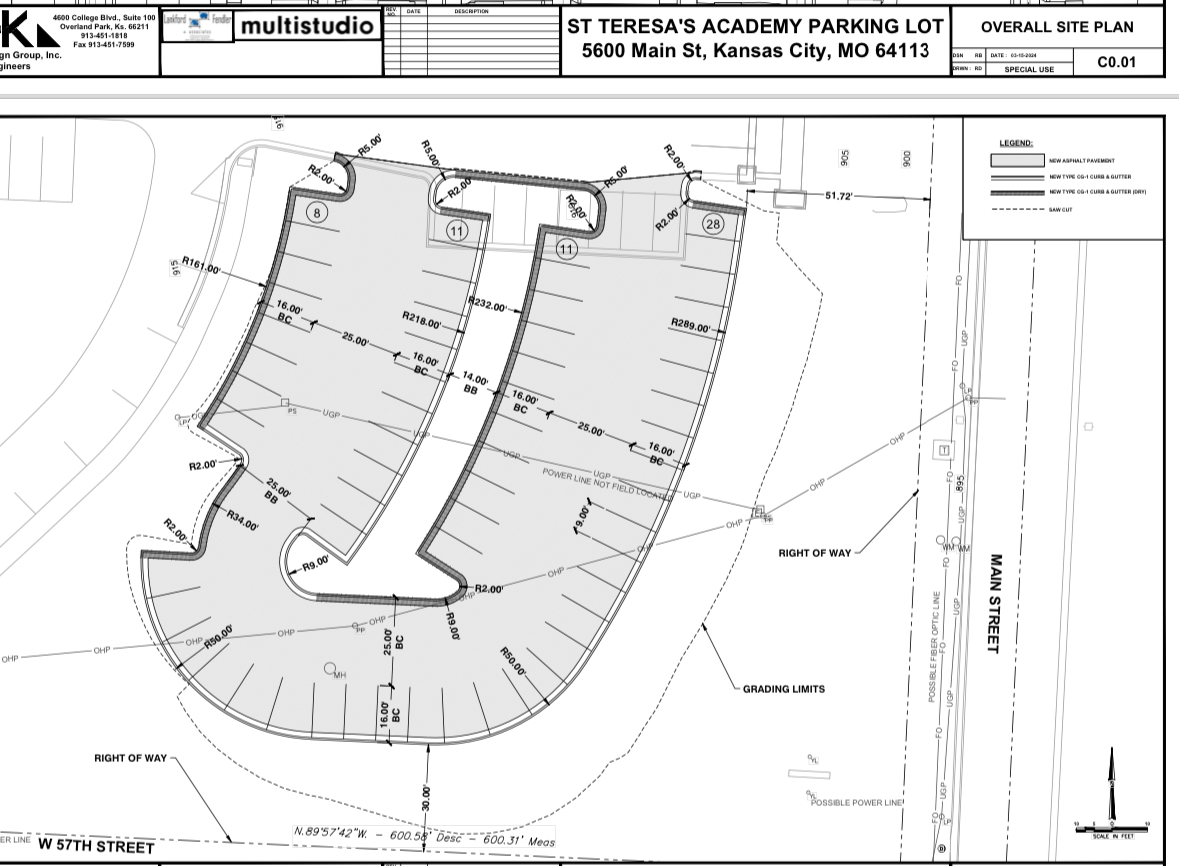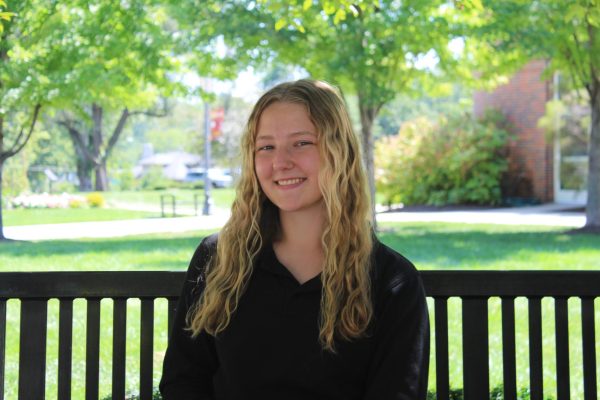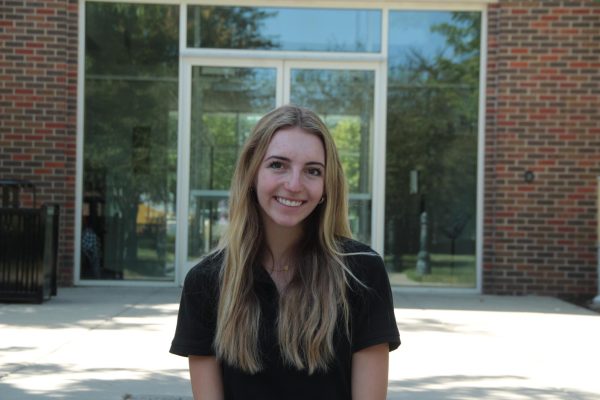On April 3, architect Tom Usher joined his neighbors in the Windmoor Center to hear from STA’s administrative team regarding upcoming parking expansions on campus.
Usher has lived in his home across the street from STA for the past 19 years. This will be the second time the lot has been expanded since he has lived here, the first being in 2011 with the addition of the current junior lot. Until early April, the neighbors surrounding STA had not heard of the new changes set to take place.
This school year, STA’s administration and board of directors made an executive decision to add an additional 50 parking spaces to the southeast corner of campus, directly connected to the currently-existing junior lot. Construction is scheduled to begin sometime in the month of July and last roughly two weeks.
The plan is set to remove several trees and 0.66 acres of green space. The site will be leveled to accommodate the new lot, raising the height of the overall area significantly.
According to Siabhan May-Washington, president of STA, the decision is a result of concerns surrounding safety on campus, as well as parking accessibility issues for students.
In recent years, May-Washington said, there have been thefts of car parts off of STA students’ vehicles, which she believes can be addressed by moving more cars into the lot.
“There have been some instances with catalytic converter thefts on the street [and] even some in our lot,” May-Washington said. “If we can bring more cars off the street, our security officers can really pay closer attention to the cars that are in the lot.”
May-Washington emphasized the safety advantages of having more students parked within a lot.
“It all comes back to safety and just being able to have greater custody [and] oversight of our students, our constituents, our visitors,” she said. “It really comes down to safety and convenience, not only for current students…[but also for] anyone who comes to our events. We need to be able to have more parking.”
The issue expands beyond safety, however: the administration plans to use the expansion to minimize the number of students parking on the streets surrounding STA.
“The primary reason that we are expanding the parking lot is because too many students and visitors have to park in the streets,” May-Washington said. “We want to eliminate [this issue] as much as possible, bring more cars on our property and eliminate some of the street congestion that’s taking place.”
Usher, along with many of his fellow neighbors, expressed concerns about the way in which STA informed neighborhood residents of the impending project, specifically at the neighborhood meeting.
“They came to us too late,” Usher said. “They already had the design. They told us on April 3rd that they considered eight or nine different locations, and they settled on this one. We were all in the room going, ‘I thought that’s what we were here for, was to give feedback on what was in the best interest of everybody.’ We felt a little hurt that we weren’t brought into the process earlier.”
Usher explained that his experience with the current project has been different from that of the previous 2011 expansion, in which he felt STA was more receptive to neighborhood concerns.
“I feel like we worked together, and St. Teresa’s listened to us,” he said. “I stood in favor of the [2011] parking lot, and I think a lot of neighbors got support out of St. Teresa’s.”
In terms of the upcoming expansion, however, Usher struggled to see a benefit in the parking situation and questioned the urgency of the project.
“We’ve all lived with [the current situation] for so many years,” Usher said. “It’s really not a concern…there’s usually about 50 or 60 cars up and down Wyandotte and Westover, and there’s another 30 to 50 on Main and even 55th Terrace…so these 50 stalls are not going to put a dent in that. If it’s not really going to do anything, why do it at all?”
Usher emphasized the value in green space on the STA campus and in the neighborhood.
“I think what we’re saying is we prefer the green space,” he said. “We don’t mind people parking on the street. The asphalt is already there; let’s keep the green space. That’s what makes Brookside so wonderful – it’s not a bunch of parking lots [and] it’s not downtown.”
STA AP Environmental Science teacher and Green Team leader Sarah Holmes conveyed similar environmental worries.
“The big thing is water runoff,” Holmes said. “Adding more impervious surfaces to our parking lot means when the rain hits it, it’s just going to run off and pick up oil, gas, dirt and all sorts of things and it’s going to go to our storm drains. We need it to recharge the aquifer [so] we need it to percolate down through the soil.”
The proposed plan will increase the site’s impermeability by an additional 54.5%, according to a micro drainage study conducted in preparation for the project. In addition to the project’s impact on groundwater, Holmes communicated the project’s consequences for native species.
“I think they’re going to take out the two mature persimmon trees that we have on campus, which are an amazing thing,” Holmes said. “It’s a really cool native tree that’s rare in urban environments and provides a lot of food for all sorts of organisms: butterflies, bees, bugs and beetles.”
Holmes explored potential ways to honor the current landscape of STA if the project goes through.
“Can we mill [the persimmon trees] and make them into some benches for an outdoor classroom?” Holmes said. “The trees are gone. We still have this beautiful native persimmon wood… can we pay homage to what was here before?”
She also suggested integrating conservation into the project through the use of native plant species for new landscaping. Additionally, Holmes expressed interest in using the parking lot for educational purposes by implementing permeable pavement that students could learn about.
Holmes also proposed waiting a year to experiment with alternative solutions to the current parking issues, such as incentivized carpooling and biking.
“[Try other methods] for a year,” she said. “If after a year it doesn’t work, and people aren’t happy, then rethink it. But I like the idea of getting the neighborhood involved, letting them have a voice, talking to them about it, talking to students, talking to all of our stakeholders and then making a decision.”
She emphasized that protecting the environment is a hard task, and environmental concerns are easy to overlook.
“If you don’t study [environmental science], you don’t think about it,” Holmes said. “You don’t think about the problems with a new parking lot.”
One of the objectives of the expansion is solutions to traffic congestion. May-Washington explained that multiple options were on the table, including staggered departure times for students and the expansion of the security team.
“We’re currently looking to expand, if we can, our security team,” May-Washington said. “I would love to have security be a more mitigating force to help with traffic patterns and incoming and outgoing.”
In regard to the amount of cars using the lot, May-Washington said it may be impossible to reduce the number of drivers.
“For some students, it’s impractical; they cannot carpool with another STA student or they cannot walk or they cannot bike,” May-Washington said. “We highly respect the right of parents if they want their daughters to drive to St. Teresa’s…to do that.”
May-Washington asserted that the decision to expand the parking lot ultimately rested in the hands of the board of directors and administration.
“I’m happy to bring students to the table for other matters, but [this decision was an] administrative call,” she said. “So this decision was primarily administrative and board-directed, and students are not part of the conversations.”
She maintained that STA planned to stay central to the best interests of students.
“At the end of the day, St. Teresa’s Academy has every right to make decisions that are in our best interest,” May-Washington said. “We do care greatly for our neighbors, and so we are going to listen to our neighbors, but ultimately [make] decisions that are best for our students and our constituents. You will never be able to please everyone. But as long as our decisions are being made with intention, according to our mission, according to the best interest of our students, that’s what we will do.”
Nevertheless, neighbors continue to express concerns about the expansion.
“I have no doubt that this will be heavily landscaped, and it will be nice,” Usher said. “But once the green space is gone, it’s gone. It won’t be back.”
Holmes hopes that going forward, STA’s status as a Missouri Green School, the only one in the Kansas City area, will help to frame future projects within an environmental and sustainable lens.
“It’s a complex issue, and there [are] a lot of different sides to it,” Holmes said. “You have to be sensitive to that. But I also think that sometimes the voice of the environment is not the first one that people think about. It’s not the one that people hear because they’re non-human beings, right? We tend to prioritize the rights of humans and not the rights of other things.”







